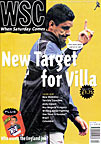 The Stade de France won over fans of the national team, but so far no suitable club side has been found to play there. Philippe Broussard runs down the possible contenders
The Stade de France won over fans of the national team, but so far no suitable club side has been found to play there. Philippe Broussard runs down the possible contenders
The Stade de France, venue of the most recent World Cup final, is now an institution, almost an historic monument. Les Bleus winning the World Cup means that, like Wembley, thousands of tourists visit the Stade. But it hasn’t always had such a positive image. A year ago, at the time of the official opening (January 28th, 1998), there was more criticism than praise. The press wondered what kind of future such a structure could have: was an 80,000-capacity stadium way too large for a country in which football draws many less people than in Italy or England? Was it not a risk to build it in a depressed suburb (Saint-Denis) where spectators would think twice about going? And, most importantly, who would use the ground once the World Cup was over?
Alongside these questions there was a large financial worry. In the long run it appeared difficult, impossible even, to make money out of such an expensive (£270 million) construction. Whether football fans or not, the French taxpayers were wondering if they were going to be paying for this monumental edifice for years to come.
The World Cup changed the focus of the problem. Now no one questions the existence of the Stade, which has become part of our national heritage almost overnight. Even if the fans complain that it is “cold” and not very conducive to a great atmosphere, this “French Wembley” now hosts France’s international fixtures as well as the finals of the French Cup and League Cup. The French rugby team plays its Five Nations matches there, building up to the rugby World Cup next autumn. Various other events have taken place there, including concerts (the Rolling Stones), motorbike races and a rally on ice. With over 20 events planned for 1999, the stadium is hardly sitting idle.
However, the debate over the stadium’s future and profitablility isn’t over. The major problem is the absence of a top level football club that would make the stadium its home. The only big Parisian club capable of regularly filling the ground, Paris St Germain, have refused to leave their current home, the 45,000-capacity Parc des Princes.
PSG fans, an average of 39,000 this season, are very attached to their “Parc” and they don’t want to hear talk of a move to Saint-Denis. According to them the Stade de France is primarily a national stadium and, with its wide-open, spacious terraces, is not built for club football. Its location does not help either: there are very few cafes or restaurants.
As the board cannot run the risk of conflict with the fans, PSG willl stay at the Parc des Princes, in the posh districts of south-west Paris. There are plans to renovate and modernise the ground. Yet it is not inconceivable that PSG will play some European matches at the Stade de France, in the way that Arsenal held Champions League games at Wembley.
With PSG out of the equation, a number of other suitors for the Stade de France have offered themselves, though none really fit the bill. Second Division Red Star were the first to express a willingness to move in. This old club, based in the northern suburbs, near the capital’s flea market, has only has two or three thousand regular supporters, but its youth programme produces a number of players.
To bring their plans to fruition, Red Star’s directors hope to attract some powerful sponsors who are keen to invest in football. The major objective is promotion to the First Divsion and to become a serious rival to PSG. Red Star hope the young people of the Parisian suburbs will fill the stands of the Stade de France. This project, which is currently lacking financial support, has been welcomed cautiously by football followers. At the moment, no one can envisage Red Star, badly placed in the league, suddenly becoming powerful and well organised. The plan, which is being closely watched by the government, will be examined in the spring. Other potential occupants could join the race and even overtake Red Star, in particular Racing Club de Paris, who were briefly revived as a professional outfit in the 1980s, before returning to their current amateur status in the regional leagues.
In January, Bernard Tapie, the disgraced former president of Marseille, announced that he was helping a Third Division club from the suburbs, Olympique Noisy-Le-Sec, formulate plans to move to the Stade de France. Noisy-Le-Sec draws its players largely from the Arabic and African communities in the suburbs and Tapie expressed his aims purely in terms of social engineering. “A second club in Paris as well as PSG, that is indispensable. It is a basic need for the suburbs to cool tempers.”
Officials at the Department of Sport admitted meetings had been held to discuss the Noisy-Le-Sec option, but the club would have to be promoted to the Second Division before they could play at the Stade de France and would also need a budget of at least £4 million.
In the meantime the biggest ground in the country does not know whether it will have a resident club in the coming years. The management aren’t worried though – the French taxpayers are subsidising the current losses.
From WSC 146 April 1999. What was happening this month